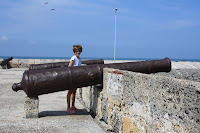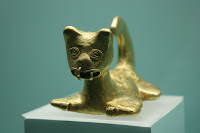 town was named after Cartagena, Spain, where most of Heredia's sailors were from. The dramatically increasing fame and wealth of the prosperous city turned it an attractive plunder site for pirates and corsairs (French privateers, licensed by their king). Just 30 years after its founding, the city was pillaged by the French nobleman Jean-François Roberval. The city then set about strengthening its defences and surrounding itself with walled compounds and castles.
town was named after Cartagena, Spain, where most of Heredia's sailors were from. The dramatically increasing fame and wealth of the prosperous city turned it an attractive plunder site for pirates and corsairs (French privateers, licensed by their king). Just 30 years after its founding, the city was pillaged by the French nobleman Jean-François Roberval. The city then set about strengthening its defences and surrounding itself with walled compounds and castles.Entering Cartagena is interesting. You can go through the big shipping channel Boca Chica - or you can take a cut over the underwater wall and sneak into the harbour. The underwall wall was built to keep invading ships and pirates from coming into the city. The wall has a relatively narrow cut in it - allowing you to pass over a depth of 11 feet. Now it is well marked with buoys so it is not quite as challenging. We entered over the wall. No fear in this crew!
Cartagena is a city for walking, and its historic walled district feels like a Moroccan medina, with 300-year-old Spanish colonial buildings huddled along brick streets. The palette is saturated with deep blue, dusty rose, burnt orange and ochre. Cool sea breezes and plenty of shade make the old city feel more comfortable even in the 90-degree heat. Our first wander through the walled city was with our dear friends on Whiskers who delayed their departure to meet up with us and show us around.
There is a neat public park near the old city where 4-foot long wild iguanas, red squirrels and tiny monkeys are hand fed by the locals.
The 400-year-old stone walls encircling the city are surprisingly intact and stretch for more than two miles. The walls are more than 16 feet thick and many places you can walk on top of the walls and see the view to the sea.




It is quite safe here and relations between Columbia and the United States have warmed in the last decade and we have felt welcomed by the people. There are more than 150 boats now in the anchorage and another 200 boats at the two marinas. I would guess that 40% of the boats are from the United States. Each morning at 8AM there are announcements in English on our VHF radio about what is going on and things to do for the day.
We were lucky to get into the nicer of the two marinas because I had communicated with one of the Club de Pesca members back in September and he had contacted a couple of the key people at the club. We ran into several cruisers who had been told that no room was available and that reservations needed to be made a year in advance. Furthermore, we were at the very end of the dock T head which gave us unobstructed views of the walled city and the bay. We also had good breezes of which we were largely unaware since the air conditioners ran non-stop while we were docked.
Many evenings, when it cooled down to the comfortable low 80s, we strolled around the city. Vendors are selling “tinto” in thermoses any hour of the day. These were small cups of that rich Columbian coffee sweetened with sugar. We could buy 2 large cups and a small cup for Emily, all for about 50 cents. We are hoping Starbucks prices never make it here! It was delicious and is truly unique to Cartagena.
We spent one day touring several museums within the old city with the crews of Nighthawk and Going South.
Our firist stop was the Museo de Oro, or Gold Museum. The museum includes valuable pre-Columbian gold artifacts, some of the oldest ceramics in the Americas, an explanation of the Zenú Nation's amazing hydraulic engineering achievements and a mountain of information about the way the native people lived. The ancient Zenú smiths used an alloy of copper and gold known as Tombac. Diagrams in the museum demonstrate how the ancient craftsmen, starting around 500BC, became proficient in both the lost wax and filigree methods of goldsmithing. The pieces were very detailed and some were breathtaking. Gold was so plentiful, even fish hooks were made from it.
The next stop was the Naval Museum. Its collection includes a permanent exhibition relating to Cartagena naval military history, marine navigation, and the Colombian Navy from both Colonial and Republican periods.
The last museum was the Palace of Inquisition. It was home of a tribunal of the Catholic Church where everyone they viewed as a heretic had been questioned and sentenced. The methods were quite brutal. It was instructional for Emily to see how fear and overzealous religious leaders can make terrible mistakes.
The palace contains instruments of torture as well as documents, paintings and explanations about the Inquisition. Outside, fronting Calle de la Inquisición, is the small, barred window from which the sentences were announced to the public. One highlight of this museum was the wonderful paintings of Columbian life.
Another day we toured a massive fort atop a hill overlooking the city and harbor. Dominating the landscape of Cartagena is the imposing Castillo de San Felipe de Barajas – the largest fort ever built by the Spanish in their colonies. The basic structure was built between 1639 and 1657 on top of a 40-meter hill in the middle of the city.
Five years later, they started an extensive enlargement, resulting in the entire hilltop being covered by the massive structure. This structure was the strongest fort ever and was never taken despite numerous attempts.
Built into the fort is a complex network of tunnels connecting various strategic points. Many of these tunnels are open to the public. Emily had fun sneaking through the underground tunnels that connected the different areas.














































5 comments:
Happy Holidays to the Emily Grace and all who sail with her. Glad to see you are all still living the dream!
Hi Kim, Tom and Emily, First I want to say a belated HAPPY BIRTHDAY to Emily and secondly wish you all HAPPY HOLIDAYS . May 2010 bring you a great and safe adventure. Big snow fell here a week ago, but we are now getting rain, so big snow gone.I read with great interest you blogs and print them out every month. Great book material. Love Henrietta Ploszaj
Happy New Year!! Hard to believe it's already been a year since you were here in Florida. I love reading your blog posts. Hope you have a wonderful, safe and blessed 2010. Godspeed!
- Bob
I just randomly came across your blog and really enjoyed reading through it!
I spent hours walking around those streets with a map in my hands. No hurry, just seeing people, historical houses, churches, eating....thinking twice, forget the map! Just get lost and latter find yourself amazed by the place. Love Cartagena and love Colombia!
Josefina - Colombia Travel
Fabulous and breathtaking photos! Columbia is such a nice place to spend a memorable holiday.
Post a Comment